NEW SECTION - More details coming soon. Available for sale.
NEW SECTION - More details coming soon. Available for sale.
NEW SECTION - More details coming soon. Available for sale.
NEW SECTION - More details coming soon. Available for sale.
NEW SECTION - More details coming soon. Available for sale.
NEW SECTION - More details coming soon. Available for sale.


Adapters
An adapter is a male component that connects to a female coupler, ensuring a secure, leak-proof connection with cam arms. Various types of adapters are available for specific applications.
Adapters offer a stable connection with no moving parts, and the choice depends on system requirements like hoses or fittings.
They lock into a female coupler with cam arms, eliminating the need for tools.

A
AR
Adapter to Female

AR
AR
Adapter to Female
Reducer

ACR
Adapter to Coupler
Reducer

F
Adapter to Male

FR
FR
FR
Adapter to Male
Reducer

E
FR
FR
Adapter to Barb

ER
FR
ER
Adapter to Shank

DP
FR
ER
Plug

SA
SA
SA
Adapter to Adapter
Coupler
Couplers are the female components of the camlock fitting system, pairing with male adapters for quick, secure, and leak-proof connections. They adapt the camlock system to hoses, threaded pipes, or equipment. Unlike adapters, couplers have cam arms, acting as the active locking component.
The coupler features cam arms (levers)
- Lock the adapter in place, ensuring a tight seal without tools.
- Allow for fast, tool-free connection and disconnection with a male adapter
- Arms are engaged; they pull the adapter against a gasket, creating a reliable, leak-proof joint.
- The locking action ensures the connection holds under pressure or vibration, reducing the risk of accidental disconnection.
Coupler

B
BR
Coupler to Male

BR
BR
Coupler to Male
Reducer

D
Coupler to Female

DR
Coupler to Female
Reducer

C
CR
CR
Coupler to Barb

CR
CR
CR
Coupler to Barb
Reducer

DD
CR
DD
Coupler to Coupler

DC
CR
DD
Dust Cap

B LOCK
B LOCK
B LOCK
Coupler to Male
SELF LOCKING

D LOCK
B LOCK
B LOCK
Coupler to Female
SELF LOCKING

C LOCK
B LOCK
C LOCK
Coupler to Shank
SELF LOCKING
Elastomers
Nitrile
Silicone
Nitrile
Good for most application
Temp -22 to 212 F
Aka: Buna-N, Buna, NBR
EPDM
Silicone
Nitrile
Widely used in agriculture applications.
Temp -22 to 228 F
ka: EPR
FKM
Silicone
Silicone
Used for high temperature, chemicals, or very corrosive applications.
Temp -22 to 212 F
aka Viton
Silicone
Silicone
Silicone
Widely used in Food & Beverage.
Temp -58 to 392
Replacement Arms

Brass Arm

Stainless Arm

Chain
Chain

Key Considerations for Material Choice:
- Compatibility: Ensure the material resists the liquid or gas properties.
- Pressure/Temperature: Stronger materials are needed for higher pressures/temperatures.
- Environment: Corrosion-resistant options are preferable outdoors.
- Cost: Aluminum and polypropylene are budget-friendly; stainless steel and exotic alloys are pricier.
- Weight: Lightweight materials are easier to handle.
Materials are listed by the volume.
1. Aluminum
Properties: Lightweight and corrosion resistant.
Use: Common in irrigation and fuel transfer.
Limitations: Not for highly corrosive chemicals or extreme temperatures.
---------------------
2. Stainless Steel
Properties: Highly corrosion-resistant and strong.
Use: Suitable for harsh environments and corrosive substances,
----------------------
3. Polypropylene
Properties: Lightweight and chemically inert.
Use: Used in agriculture and chemical transfer for fertilizers and mild chemicals.
Limitations: Lower strength; not for high-pressure applications.
----------------------
4. Brass
Properties: Corrosion-resistant and durable.
Use: Common for water, hydraulic oils, and gasoline, particularly in marine applications.
Limitations: Not suitable for strong acids or alkalis.
---------------------
5. Nylon
Properties: Stronger than polypropylene and resistant to abrasion.
Use: Similar to polypropylene, but offers better durability for water and fertilizers.
Limitations: Limited temperature range; less resistant to strong acids.
------------------
Other material Ductile Iron, Hastelloy, and other Exotic Alloys
-
Copyright © 2021 ONE TEAM PRODUCTS - All Rights Reserved.
This site is protected by reCAPTCHA and the Google Privacy Policy and Terms of Service apply.
This website uses cookies.
We use cookies to analyze website traffic and optimize your website experience. By accepting our use of cookies, your data will be aggregated with all other user data.